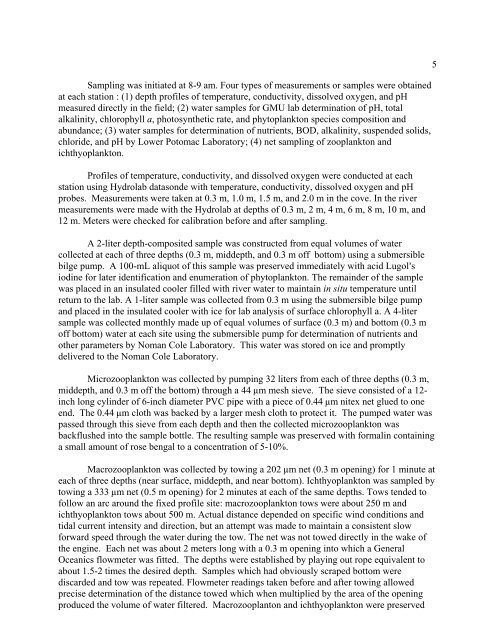NEW: Annual Report - George Mason University
NEW: Annual Report - George Mason University
NEW: Annual Report - George Mason University
Create successful ePaper yourself
Turn your PDF publications into a flip-book with our unique Google optimized e-Paper software.
Sampling was initiated at 8-9 am. Four types of measurements or samples were obtained<br />
at each station : (1) depth profiles of temperature, conductivity, dissolved oxygen, and pH<br />
measured directly in the field; (2) water samples for GMU lab determination of pH, total<br />
alkalinity, chlorophyll a, photosynthetic rate, and phytoplankton species composition and<br />
abundance; (3) water samples for determination of nutrients, BOD, alkalinity, suspended solids,<br />
chloride, and pH by Lower Potomac Laboratory; (4) net sampling of zooplankton and<br />
ichthyoplankton.<br />
Profiles of temperature, conductivity, and dissolved oxygen were conducted at each<br />
station using Hydrolab datasonde with temperature, conductivity, dissolved oxygen and pH<br />
probes. Measurements were taken at 0.3 m, 1.0 m, 1.5 m, and 2.0 m in the cove. In the river<br />
measurements were made with the Hydrolab at depths of 0.3 m, 2 m, 4 m, 6 m, 8 m, 10 m, and<br />
12 m. Meters were checked for calibration before and after sampling.<br />
A 2-liter depth-composited sample was constructed from equal volumes of water<br />
collected at each of three depths (0.3 m, middepth, and 0.3 m off bottom) using a submersible<br />
bilge pump. A 100-mL aliquot of this sample was preserved immediately with acid Lugol=s<br />
iodine for later identification and enumeration of phytoplankton. The remainder of the sample<br />
was placed in an insulated cooler filled with river water to maintain in situ temperature until<br />
return to the lab. A 1-liter sample was collected from 0.3 m using the submersible bilge pump<br />
and placed in the insulated cooler with ice for lab analysis of surface chlorophyll a. A 4-liter<br />
sample was collected monthly made up of equal volumes of surface (0.3 m) and bottom (0.3 m<br />
off bottom) water at each site using the submersible pump for determination of nutrients and<br />
other parameters by Noman Cole Laboratory. This water was stored on ice and promptly<br />
delivered to the Noman Cole Laboratory.<br />
Microzooplankton was collected by pumping 32 liters from each of three depths (0.3 m,<br />
middepth, and 0.3 m off the bottom) through a 44 µm mesh sieve. The sieve consisted of a 12inch<br />
long cylinder of 6-inch diameter PVC pipe with a piece of 0.44 µm nitex net glued to one<br />
end. The 0.44 µm cloth was backed by a larger mesh cloth to protect it. The pumped water was<br />
passed through this sieve from each depth and then the collected microzooplankton was<br />
backflushed into the sample bottle. The resulting sample was preserved with formalin containing<br />
a small amount of rose bengal to a concentration of 5-10%.<br />
Macrozooplankton was collected by towing a 202 µm net (0.3 m opening) for 1 minute at<br />
each of three depths (near surface, middepth, and near bottom). Ichthyoplankton was sampled by<br />
towing a 333 µm net (0.5 m opening) for 2 minutes at each of the same depths. Tows tended to<br />
follow an arc around the fixed profile site: macrozooplankton tows were about 250 m and<br />
ichthyoplankton tows about 500 m. Actual distance depended on specific wind conditions and<br />
tidal current intensity and direction, but an attempt was made to maintain a consistent slow<br />
forward speed through the water during the tow. The net was not towed directly in the wake of<br />
the engine. Each net was about 2 meters long with a 0.3 m opening into which a General<br />
Oceanics flowmeter was fitted. The depths were established by playing out rope equivalent to<br />
about 1.5-2 times the desired depth. Samples which had obviously scraped bottom were<br />
discarded and tow was repeated. Flowmeter readings taken before and after towing allowed<br />
precise determination of the distance towed which when multiplied by the area of the opening<br />
produced the volume of water filtered. Macrozooplanton and ichthyoplankton were preserved<br />
5
















